| |
Travel in early fall is
a great option for avoiding crowds
in France while enjoying warm and sunny days. My wife and I wanted to
lounge
and swim for a week on the Riviera (Côte d'Azur) and then drive north
through
the Rhone Valley, stopping for several days in interesting towns,
before ending
our three-week sojourn in France's Alsace wine region. It didn't take
long to
settle on an itinerary that proved to be ideal: Saint-Tropez, Arles,
Beaune,
and Colmar. The driving time totaled less than twenty hours. Open-leg
flights
to and from France via Nice and Strasbourg provided convenient
access
from the United States. The one-way car rental was available at
no additional charge.
Saint-Tropez
Sitting on a beautiful
curved peninsula overlooking its
graceful bay north to the mainland, Saint-Tropez is a vacationer's delight.
The
village's narrow lanes wind up from Old Port to an ancient
castle and fortress with
inviting views over the town and sea. The port has a surprising blend
of
open-bowed boats of resident fisherman and yachts of the rich and
famous� who
prize Saint-Tropez' charm. 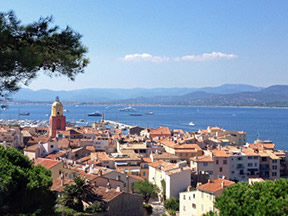 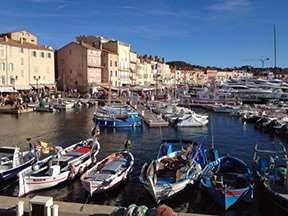
Saint-Tropez Village, Bay, and Port
We stayed in the old
town section in an apartment that
provided easy access to the port and beaches to the east. The waters
here in
late September were warm for swimming, with uncrowded shores. A
pedestrian coastal pathway extends eastward from the port,
providing
access to many isolated coves perfect for a dip in the sea.
Bicycle rentals were
readily available, and we discovered
a safe pleasant biking lane that circled clockwise around Saint Tropez
bay from
the village to Sainte-Maxime. Port Grimaud provided a convenient
seaside stop
for lunch during our cycle tour.
A drive southwest on
route D-559 provided access to a
serenely gorgeous section of coastline with beaches and villages
between
Cavalaire-sur-Mer and Le Lavandou. We took a day to explore, finding
two
inviting beaches hidden by steep forested hillsides descending to the
sea.
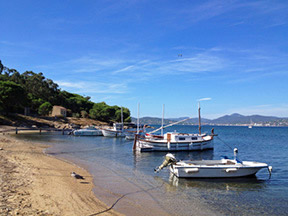 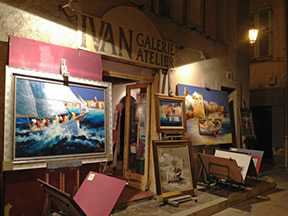
Coastline Beach and Art Gallery of Saint Tropez
On another day we took a one hour boat tour of the
bay,
encountering many sloops sailing in the brisk afternoon wind. We
stopped at
Sainte-Maxime's port, and then glided along the coastline east of
Saint-Tropez
to view seaside estates such as Brigitte Bardot's and the prior
residence of
Pointillist painter Paul Signac. On debarking back in Saint-Tropez we
availed
ourselves of the nearby museum, l'Annonciade, to appreciate its
collection of
paintings by Signac, Matisse, Seurat, Braque, Bronnard, and Derain. As
we later
relaxed at a portside café, we agreed that Saint-Tropez had become our
favorite
Côte d'Azur village.
Arles
Just upriver from the
Rhone's delta region sits the
fantastic town of Arles with its array of Roman sites, narrow lanes of
old
homes and apartments, and many medieval churches. We rented an
apartment in the
ancient quarter, just steps from the Roman Arena. Over 1,900 years old,
today
it's the site of weekend bullfights. Situated atop Arles' highest hill,
the
well-maintained structure provides picturesque views of the town and
the river.

Arles' Roman Arena
After
touring the arena we wound our way down rue des Arènes to place du
Forum,
originally the Roman center of town, now a café-crammed plaza bursting
with
energy among shady sycamore trees. It was here that Van Gogh hung out
in the
1880s and painted Starry Night. This was a great
place to soak up the
ambiance and enjoy a plaza lunch. The nearby place de la République and
St.
Trophime Cloisters and Church also merited our visit. We finished our
day's
explorations with an enthralling visit to the Roman structure
underlying the
Place du Forum. This site was the ancient city's cryptoporticos.
Constructed by Julius Cesar about 40 B.C., these were the
administrative,
judicial, and economical offices of the ancient city.
 
Arles Street Market and Local Shops
On
another day we toured the protected wilderness region of the Rhone's delta, the
Camargue. Here we found a very rewarding hike on the trails surrounding Capelière, the administrative center and museum for the
Natural Reserve. We sighted many birds, frogs, fish, and insects along the marshy
rivulets and ponds. At the bank of the large body of water titled Etang de
Vaccarès we had the good fortune to
watch a flock of grand flamingos feeding in the shallows. Further explorations
provided citing of wild horses that inhabit the region, the small white
Camargue horses. This ancient breed is believed to have existed here for
thousands of years. We were also pleased to find a number of Camargue bulls.
This wild breed of black, curved-horn cattle is also native to the region. Today
they
live semi-wild, tended by mounted herders called gardians.
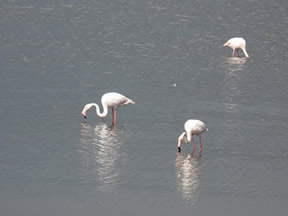 
Camargue's Fauna: Giant Flamingos, Bulls, Wild Horse [Photos by Rita Furnanz]
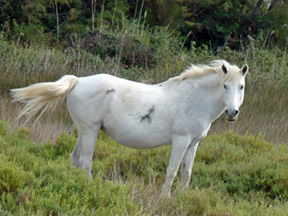
Beaune
Rolling hills of vineyards surround the historic walled
city of Beaune, wine capital of Burgundy. The medieval town's heyday was the 15th
century when its dukes controlled a vast area stretching to Holland. Today's
visitors enjoy Beaune's preserved architecture, ancient wine-tasting cellars
and the famed site, Hotel Dieu. This medieval charity hospital was built in 1443
by ruling chancellor Rolin as tribute to his realm after the devastating losses
of the Hundred Years' War and the Black Plague.
We rented an apartment in the center of old-town and
started a relaxing day of exploration with a visit to Hotel Dieu. Its bland
exterior walls enhanced our surprise as we viewed the exquisite main courtyard
highlighted by colored roof tiles. The rewarding self-guided tour included
visits to historic wards that housed an array of patients from paupers to the
rich. Other interesting rooms included the chapel, kitchen, and pharmacy. After
a tasty local lunch with a glass of Burgundy, we enjoyed Beaune's array of
other sites: a walk along the ramparts; visit to the 12th-century
cathedral Collégial
Notre-Dame; and a delightful tour of wine cellars and wine-tasting stations at
Marché aux Vins. It was a great means to end the day before an excellent dinner
at La Ciboulette near the northern town gate.
A vineyard and village tour provided another relaxing and
enjoyable day of Burgundy exploration and wine tasting. On the ten-mile circle
route we visited the villages of Savigny and Pernand-Vergelesses, surrounded by
steep hills of vines. We ended at Aloxe-Corton where we ate our sack lunch on
the steps of its church overlooking immaculate vineyards.
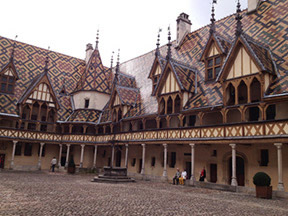 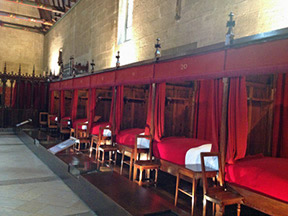
Beaune's Hotel Dieu Courtyard and Ward
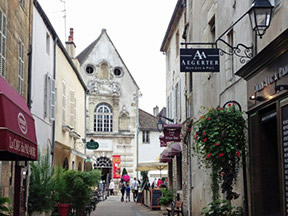 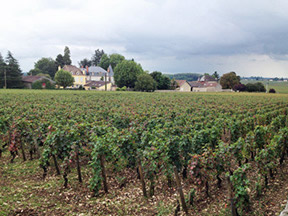
Beaune Street Scene and Nearby Burgundy Vineyard
Colmar
Situated as the
capital of Alsace's wine route, Colmar provided the perfect end for our
south to north France sojourn. It is one of Europe's most charming cities, known
for its well-maintained display of centuries-old French and Germanic heritage.
We were fortunate to have found an apartment in the midst of the Little Venice
area. Here the canals of the Lauch River are lined with beautiful homes
sporting Colmar's unique half-timbered facades and shuttered windows.
Colmar provided
a busy and eventful day of explorations. We started with a visit to the
Unterlinden Museum with a widely varied collection ranging from painting to
winemaking history to the renown Isenheim Altarpiece. This 1515
masterpiece consists of three hinged, interlocked images: the nativity,
crucification, and resurrection of Jesus Christ. Other town highlights of our
tour included Maison des Tetes, a home decorated with 105 faces, Maison
Pfister, a richly decorated merchant's house from 1537, the Dominican
Church and Saint Martin Cathedral, the old Customs House, and the Market Hall
with its lively stalls of produce, meat, and fish. We ended our day with coffee
and aperitifs along a canal in Little
Venice, followed by an incredible lamb shank dinner at nearby Le Petit Gourmand,
9 Quai de la Poissonnerie.
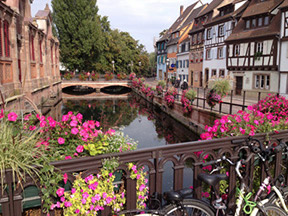 
Colmar Canal and Cathedral
On the last day of our trip
we drove among vineyards to visit four fantastic Alsatian wine villages, providing
excellent opportunity for tasting and purchase of Alsace's world-famous
Reisling. The uniquely dry climate (23 inches of annual rainfall) perfectly suits this
excellent white wine grape. We started early at the trip's northern extremity
in beautiful Riquewihr. We then traveled south to Albert Schweitzer's home
village of Kaysersberg, then to Turckheim, and ended at our favorite village,
Eguisheim. This almost perfectly round medeival village provided an enchanting
self-guided tour of flower-bedecked homes along the ancient wall before heading
along picturesque lanes and squares to central Place du Marché. The Alsace region provided a perfect ending to
our France sojourn.
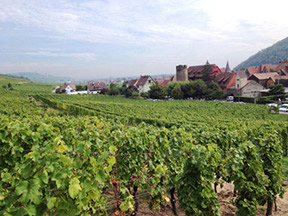 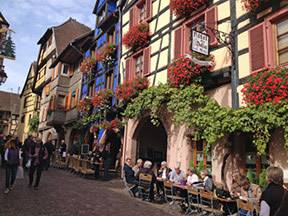
Riquewihr's Reisling Vineyards and Main Lane
References
Travel book and useful Web sites:
- Rick Steves� France
(available at books stores & www.amazon.com,
covers all except Saint Tropez)
- Saint Tropez
- Arles
- Camargue
- Beaune
- Colmar
- Alsace Wine
|